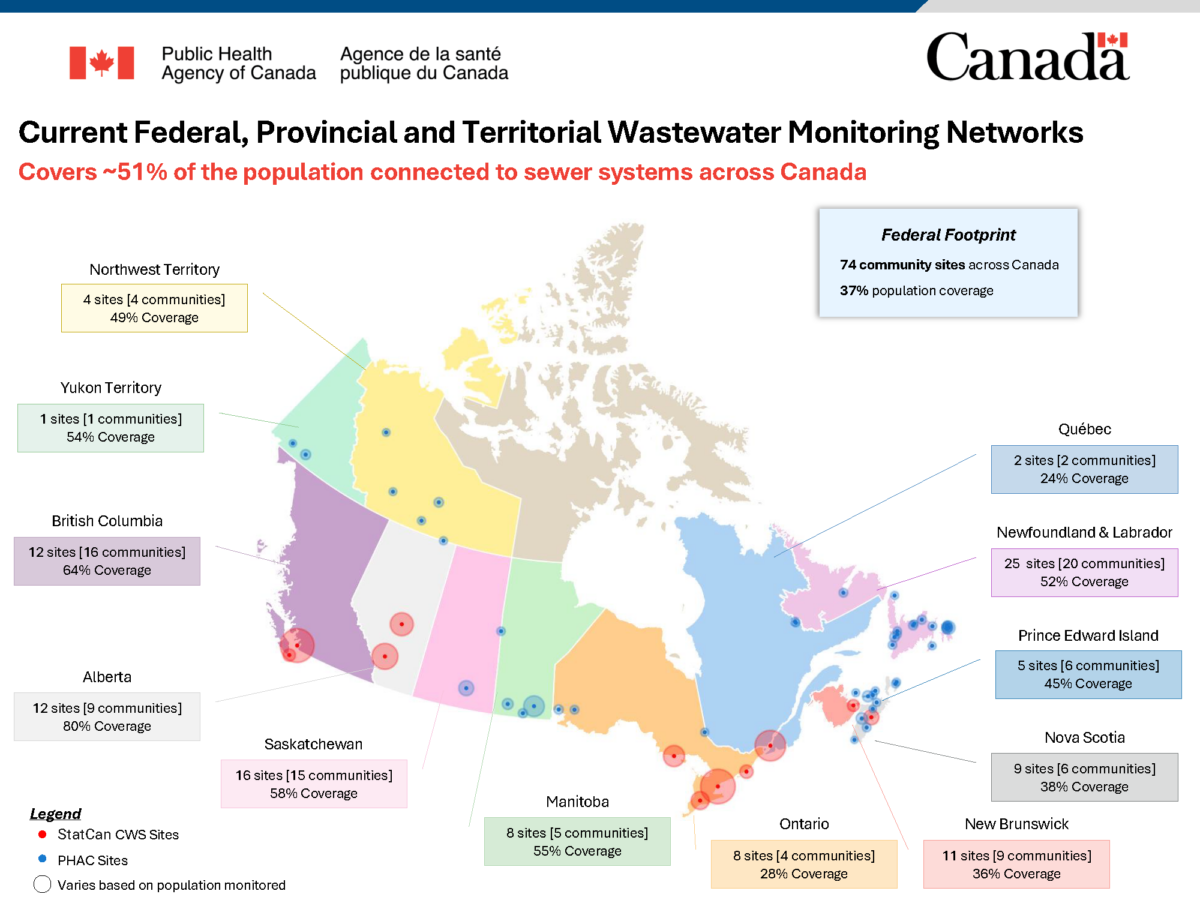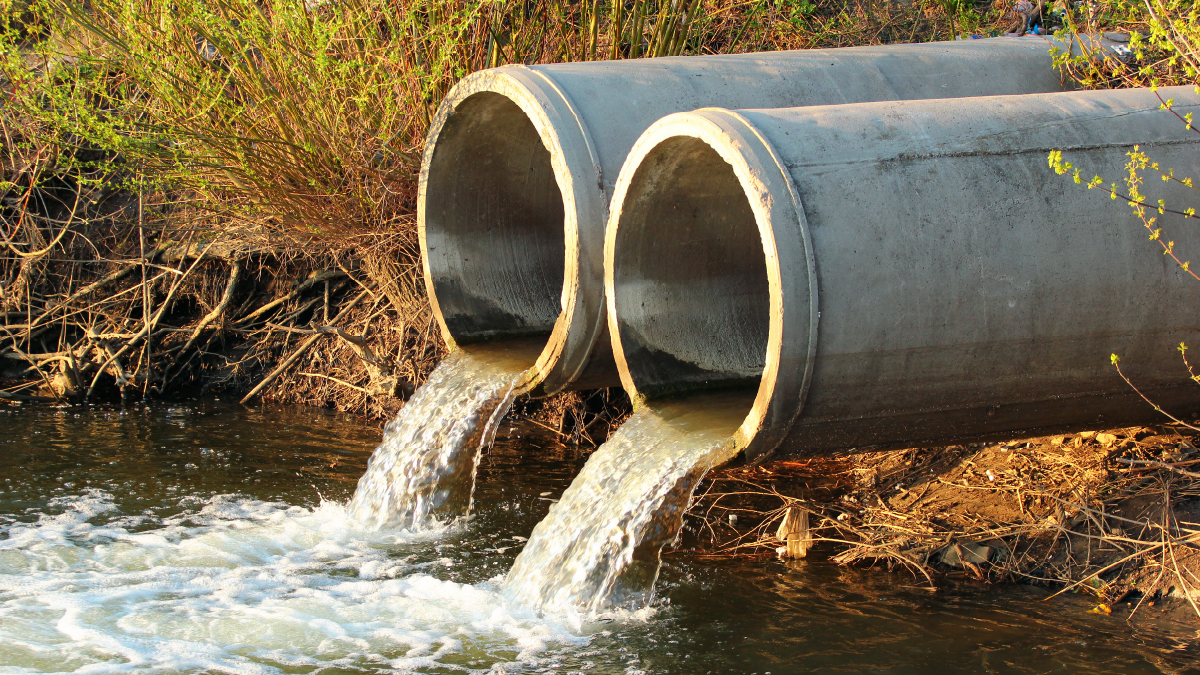April 27, 2025
Wastewater monitoring can identify the presence and abundance of pathogens, biological or chemical markers indicating the health of a community, and drug and substance use patterns within a population over time.
Pathogens, including viruses such as SARS-CoV-2, influenza viruses, respiratory syncytial virus (RSV), and mpox virus are shed in the stool and urine of infected people over a significant portion of their illness. Even if a person does not have symptoms, they can still shed pathogens into the wastewater (sewage) system. This provides an opportunity to test and monitor wastewater (sewage) for the presence of infectious diseases in communities and institutional settings (e.g. long-term care facilities) without the need for individual testing. Wastewater monitoring can also be used to monitor the circulation of variants of concern (VOC) and, in some circumstances, can be used as an early indicator for the presence of disease not yet detected by traditional clinical monitoring systems and to inform public health decision-making.
The Public Health Agency of Canada (PHAC) is working in collaboration with other federal departments, provincial, territorial and municipal governments and academia across Canada to maintain a national wastewater monitoring network capable of informing on the spread of infectious diseases in Canada.
Wastewater monitoring is a continually evolving science. Scientists continue to improve methods for detecting and measuring infectious diseases in wastewater.
Some of the PHAC’s public health research priorities include:
- Understanding how pathogens survive in wastewater, including persistence, decay, and partitioning, and how they are impacted to improve sampling and testing strategies;
- Exploring equitable sampling strategies and how they can provide more comprehensive public health monitoring of underserved populations;
- Developing and optimizing assays and methodologies for emerging or re-emerging pathogens of public health concern;
- Standardizing methods to ensure consistent, reliable results across laboratories, and improving comparability across regions;
- Improving the accuracy of pathogen quantification in wastewater; and
- Enhancing integration with clinical surveillance systems to translate wastewater data to actionable insights.
For more information: please refer to: Wastewater Monitoring (Canada.ca)
Pan-Canadian Wastewater Monitoring Network Map

National Wastewater Monitoring Dashboard
The PHAC has developed a dashboard to monitor the respiratory virus activity in some major communities across Canada over time. This data is updated Tuesdays and Fridays every week and the variant data is updated biweekly on Fridays. This data can be found here:
To compile wastewater data, we collaborate with experts across Canada, including academia, Indigenous governments, other federal departments, and provincial, territorial and municipal governments. While we act as data stewards to manage and host data, the decision to share and publish data is always at the discretion of the local jurisdictions. PHAC uses this data internally to:
- drive forecasting models and reproduction number (Rt) estimates to enhance the public health impact and utility of the data,
- integrate with other laboratory data (e.g., genomic) and epidemiologic data (e.g., incidence, severe outcomes, etc.) to generate a more holistic understanding of infectious disease risks, and
- Analyze, interpret, and summarize in a report to be shared back with provincial and local public health partners.
Wastewater-Based Modelling: Forecasting the State of the Pandemic Using Wastewater Data
The PHAC has developed a mathematical model for conducting wastewater-based forecasting that describes infections of COVID-19 in the community and also considers how infected people shed the COVID-19 virus into the sewer systems and how that shed virus signal is detected and reported. The clinical case and wastewater surveillance data are used to generate forecasts and help understand what is happening in the community.
Canadian Wastewater Survey (CWS): Modelling Report
Statistics Canada and the PHAC have been collaborating since November 2020 to conduct wastewater monitoring in Halifax, Montréal, Toronto, Edmonton, and Vancouver.
Canadian Wastewater Survey (CWS): City of Winnipeg, Manitoba Modelling Report
PHAC is working with the city of Winnipeg and the province of Manitoba to conduct wastewater monitoring in the city’s three wastewater treatment plants.
For more information on the CWS please see the following links:
Working Groups & Expert Meetings
CPHLN National Wastewater Surveillance
Through the Canadian Public Health Laboratory Network (CPHLN), public health leads in wastewater monitoring from across Canada have been brought together to establish key priorities, address gaps, and increase the impact of wastewater monitoring data at all levels of government.
PHAC Wastewater Working Group
The PHAC is leading working groups and meetings related to wastewater monitoring to discuss sampling, laboratory methods, data models, modelling and public health action and response. The meetings are held on a regular basis on rotating topics:
- Data Modelling and Epidemiological Interpretation to discuss modelling, modelling methods and interpretation of wastewater testing results as they relate to clinical monitoring.
- Wastewater Genomics to discuss the detection of variants of concern/interest in wastewater, interpretation of results, and share laboratory expertise.
- Wastewater Laboratory Detection to discuss methods (e.g. PCR, QA/QC), sampling issues, data interpretation, reporting of results, and any other topics related to laboratory methods for detection.
- Wastewater Surveillance to discuss sampling strategies, data interpretation and public health reporting and action and create a forum for moving wastewater monitoring to public health action.
Global Consortium for Wastewater and Environmental Surveillance for Public Health (GLOWACON)
PHAC is collaborating with other global public health partners, including the United States Centers for Disease Control and Prevention (US CDC) and European Commission’s Health Emergency Preparedness and Response (HERA), in the Global Consortium for Wastewater and Environmental Surveillance for Public Health (GLOWACON). The network aims to foster collaboration, research and innovation, and share best practices and expertise to enhance global monitoring of emerging threats to strengthen pandemic preparedness efforts.
Publications and Reports
Click to show/hide publications and reports.
- Conforti et al. (2025) – Strengthening Policy Relevance of Wastewater-Based Surveillance for Antimicrobial Resistance
- Fisher et al. (2025) – A targeted tiled amplicon sequencing approach for clade and subclade level differentiation of monkeypox virus from wastewater
- Giesbrecht et al. (2025) – Identification of circulating human papillomavirus types through high-throughput sequencing of Canadian municipal and institutional wastewater samples
- Seo et al. (2025) – Sporadic detection of vaccine-derived poliovirus type 2 using next-generation sequencing in Canadian wastewater in August of 2022
- Kabir et al. (2025) – Diagnostic performance of allele-specific RT-qPCR and genomic sequencing in wastewater-based surveillance of SARS-CoV-2
- Champredon et al. (2024) – ern: An R package to estimate the effective reproduction number using clinical and wastewater surveillance data
- Champredon et al. (2024) – Emergence and spread of SARS-CoV-2 variants of concern in Canada: a retrospective analysis from clinical and wastewater data
- Corrin et al. (2024) – A scoping review of human pathogens detected in untreated human wastewater and sludge
- Mejia et al. (2024) – Detection of Mpox Virus in Wastewater Provides Fore-Warning of Clinical Cases in Canadian Cities
- Oloye et al. (2024) – Solid-liquid distribution of SARS-CoV-2 in primary effluent of a wastewater treatment plant
- Overton et al. (2024) – Genomic Surveillance of Canadian airport wastewater samples allows early detection of emerging SARS-CoV-2 lineages.
- Sachdeva et al. (2024) – Preparing for Mpox Resurgence: Surveillance Lessons From Outbreaks in Toronto, Canada
- Asadi et al. (2023) – Assessment of rapid wastewater surveillance for determination of communicable disease spread in municipalities
- Asadi et al. (2023) – A wastewater-based risk index for SARS-CoV-2 infections among three cities on the Canadian Prairie
- Champredon et al. (2023) – Editorial: Wastewater-based epidemiological surveillance of respiratory pathogens
- Fuzzen et al. (2023) – An improved method for determining frequency of multiple variants of SARS-CoV-2 in wastewater using qPCR assays
- Hasing et al. (2023) – Wastewater surveillance monitoring of SARS-CoV-2 variants of concern and dynamics of transmission and community burden of COVID-19
- Joung et al. (2023) – Coupling Wastewater-Based Epidemiological Surveillance and Modelling of SARS-COV-2/COVID-19: Practical Applications at the Public Health Agency of Canada
- Peterson et al. (2023) – RT-qPCR detection of SARS-CoV-2 mutations S 69-70 del, S N501Y and N D3L associated with variants of concern in Canadian wastewater sample
- Peterson et al. (2023) – Real-time quantitative reverse transcription polymerase chain reaction detection of SARS-CoV-2 Delta variant in Canadian wastewater
- Sachdeva et al. (2023) – Preparing for mpox resurgence: Surveillance lessons from outbreaks in Toronto, Canada
- Schmidt et al. (2023) – Realizing the value in “non-standard” parts of the qPCR standard curve by integrating fundamentals of quantitative microbiology
- Arts et al. (2022) – Community Surveillance of Omicron in Ontario: Wastewater- based Epidemiology Comes of Age
- Champredon et al. (2022) – Emergence and spread of SARS-CoV-2 Variants of Concern in Canada: A retrospective analysis from clinical and wastewater data
- Chen et al. (2022) – Antigenic drift and epidemiological severity of seasonal influenza in Canada
- Dai et al. (2022) – Statistical framework to support the epidemiological interpretation of SARS-CoV-2 concentration in municipal wastewater
- Daigle et al. (2022) – A sensitive and rapid wastewater test for SARS-COV-2 and its use for the early detection of a cluster of cases in a remote community
- Fuzzen et al. (2022) – Multiplex RT-qPCR assay (N200) to detect and estimate prevalence of multiple SARS-CoV-2 Variants of Concern in wastewater
- Hua et al. (2022) – Salivary testing for SARS-CoV-2 in the pediatric population: a diagnostic accuracy study
- Peterson et al. (2022) – RT-qPCR detection of SARS-CoV-2 mutations S 69–70 del, S N501Y and N D3L associated with variants of concern in Canadian wastewater samples
- Nourbakhsh et al. (2022) – A wastewater-based epidemic model for SARS-CoV-2 with application to three Canadian cities
- Oloye et al. (2022) – Rapid transition between SARS-CoV-2 variants of concern Delta and Omicron detected by monitoring municipal wastewater from three Canadian cities
- Xie et al. (2022) – RNA in Municipal Wastewater Reveals Magnitudes of COVID-19 Outbreaks across Four Waves Driven by SARS-CoV-2 Variants of Concern
- Barker at al. (2021) – MMMVI: Detecting SARS-CoV-2 variants of concern in metagenomic samples
- Chik et al. (2021) – Comparison of approaches to quantify SARS-CoV-2 in wastewater using RT-qPCR: Results and implications from a collaborative inter- laboratory study in Canada
- Johnson et al. (2021) – Clinical evaluation of the GeneXpert® Xpert® Xpress SARS-CoV-2/Flu/RSV combination test
- Landgraff et al. (2021) – Metagenomic sequencing of municipal wastewater provides a near-complete SARS-CoV-2 genome sequence identified as the B.1.1.7 variant of concern from a Canadian municipality concurrent with an outbreak
- Manuel et al. (2021) – The role of wastewater testing for SARS-CoV-2 Surveillance
- Moghadas et al. (2021) – Evaluation of COVID-19 vaccination strategies with a delayed second dose
- Nourbakhsh et al. (2021) – A wastewater-based epidemic model for SARS-CoV-2 with application to three Canadian cities
- Nourbakhsh et al. (2021) – Effectiveness and cost-effectiveness of RSV infant and maternal immunization programs: A case study of Nunavik, Canada
- Patriquin et al. (2021) – Generation of False-Positive SARS-CoV-2 Antigen Results with Testing Conditions outside Manufacturer Recommendations: A Scientific Approach to Pandemic Misinformation
Resources
Canadian Case Studies
Prepared by the Canadian Water Network
Prepared by University of Calgary
Guidance Documents for Wastewater Monitoring
Public Health Agency of Canada:
- Normalization Practices for SARS-CoV-2 Data in Wastewater-based Epidemiology
- Packaging Wastewater Samples for Shipment
- Wastewater Sampling and Transport from Communities
Environment and Climate Change Canada, Wastewater Science Unit:
Ontario – Ministry of the Environment, Conservation and Parks:
Webinars
The PHAC hosted this Webinar on April 1, 2021. Presentations covered laboratory methods, public health interpretation survey results, and two case studies (Ottawa and Northwest Territories).
The Health Canada Testing, Contact Tracing, and Data Strategies secretariat and PHAC organized this session covering lessons learnt from monitoring of SARS-CoV-2 in wastewater collected at wastewater treatment plants or further upstream at facility level.
Connect with Us
For any inquiries or to attend any of these meetings, please contact: nmlwastewater@phac-aspc.gc.ca

